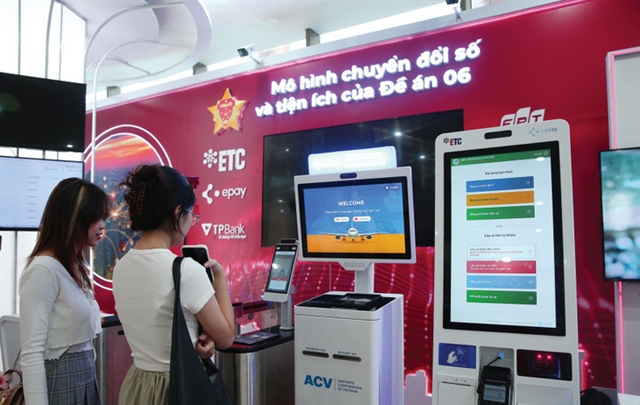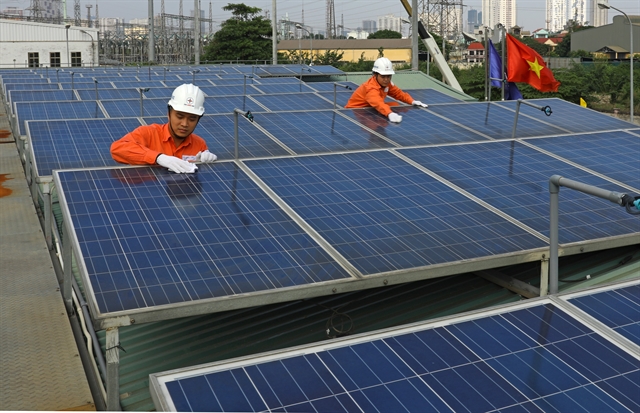 Business Beat
Business Beat


|
| Workers of Vietnam Electricity install rooftop solar panels. — VNA/VNS Photo |
Compiled by Ly Ly Cao
HÀ NỘI — The Ministry of Industry and Trade (MoIT) is seeking public opinions on a draft proposal regarding rooftop solar power for self-consumption without selling electricity to organisations, individuals, or the national grid.
The proposal gives organisations and individuals the option of injecting surplus power into the grid. If investors do not inject into the system, they must build devices to control the quantity of excess power injected into the grid. Meanwhile, in the event that excess power is injected into the grid, the state will acknowledge the electricity generation at a cost of 0 đồng.
These proposals have raised controversy among the public, as there is definitely a contradiction within the draft encouraging policy.
Speaking about the matter, the MoIT and some energy experts said that the main reason is the insufficient equipment in the national power system. Apparently, the system is not equipped to handle sudden fluctuations caused by excess solar power from rooftop installations. They claim that this could pose safety and security risks to the power grid.
Simply put, solar power relies on sunlight, and when there is no sunshine due to clouds, rain, or nighttime, the national power grid still needs to ensure a stable power supply. This leads to unpredictable and rapid changes in the system, which can cause instability. As a result, the MoIT believes that government management and supervision are needed to maintain the safe operation of the grid.
Furthermore, the regulatory authorities also want to limit the overall capacity of solar power nationwide, in line with the approved National Power Development Plan VIII. By 2030, they plan to increase rooftop solar capacity by 2,600 MW. As of the end of July, there are already over 1,000 rooftop solar systems waiting to be officially included in the plan, with a combined capacity of 399.96 MW.
Therefore, the remaining total capacity to be connected to the system from now until 2030 is only about 2,200 MW. “When the total capacity exceeds 2,600 MW, it will affect the power source structure of the system,” the ministry said.
It is critical to note that integrating 2,600 MW of solar power into the national grid not only causes technical changes in the coordination of diverse power sources such as wind, coal and hydroelectricity, but also has an influence on energy costs.
Solar power is now acquired at a high cost thanks to the prior subsidised investment process. With such large-scale integration as promised to investors by the government, it is almost guaranteed that national power generation costs will skyrocket. Otherwise, the state will be required to pay for the losses.
Energy expert, Associate Professor Doctor Trần Văn Bình believes that solar and wind power sources have low reliability, while the power system has to ensure stable operation. As a result, the system needs to determine the proportion of renewable energy sources to guarantee stability.
"Electricity is a one-of-a-kind commodity. Unlike other industries where you can produce and store in reserve, you only produce as much as you need," Bình told vnexpress.vn.
"Some nations, such as Singapore or the US, can store up to 200 MW of power, but this is still a narrative for the future for Việt Nam," he added.
“Việt Nam may have to wait 10-20 years longer for this. It is obvious that the system will encounter difficulties, and operators are not encouraged to do so because of this," he said.
Bình gives an example, stating that a 100 MW solar farm would immediately lose power in case of a sudden rainstorm. In such a situation, the power system would need immediate 100 MW compensation from other sources. Without the backup, the power system would experience a blackout, leading to an immediate power cut.
When an excessive amount of rooftop solar power is added to the electricity system, it creates an imbalance. Due to the nature of weather conditions, solar power generation is limited to daytime and cannot generate electricity during evening hours when electricity demand is high.
Therefore, if the proportion of solar power is significant, other baseload power sources, mostly thermal and hydroelectric, are needed to carry the load and ensure stable and safe power system operation.
However, due to the relatively low reserve capacity and the absence of synchronised national-scale energy storage solutions, the proportion of grid-connected solar power needs to be limited to ensure stable operation.
Speaking to Giao Thông Newspaper (Transportation Newspaper), Ngô Đức Lâm, former Deputy Director of the Institute of Energy under the MoIT, said that the ministry should have explained to people to sympathise, instead of saying nothing.
“People do not see a priority or encouragement to build rooftop solar power, but find it more complicated,” he stated.
On the other hand, the expert also emphasises the need for an objective perspective. If everyone rushes to install rooftop solar panels and inject power into the grid simultaneously, it could overload the power grid.
Particularly in the South Central region, if the transmission lines are overloaded, it may not be possible to transport electricity to the Northern region. Therefore, measures must be done to encourage the government to invest in modernising transmission lines.
Minister of Industry and Trade Nguyễn Hồng Diên has also acknowledged during the National Assembly session in November that there must be a stable baseload power source for unlimited capacity development with rooftop solar power. This implies that both technology and transmission systems need to be further developed. — VNS




